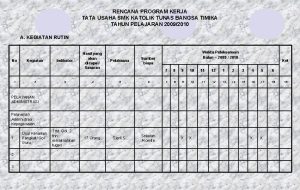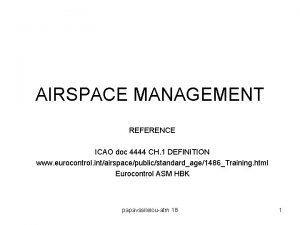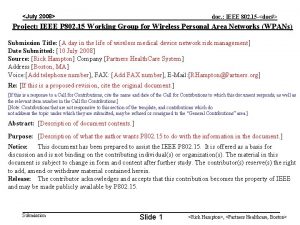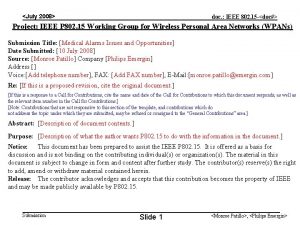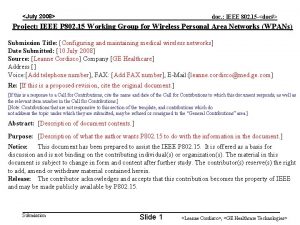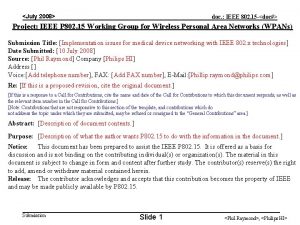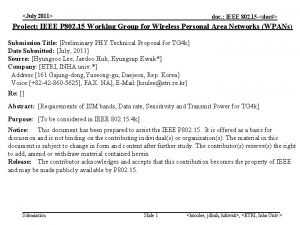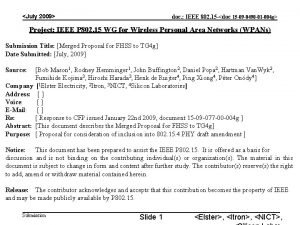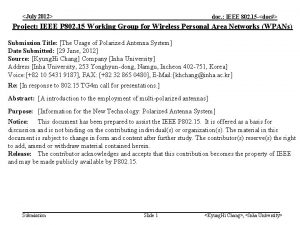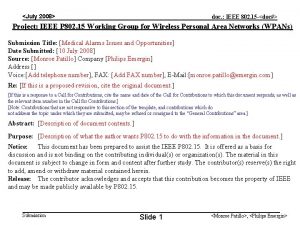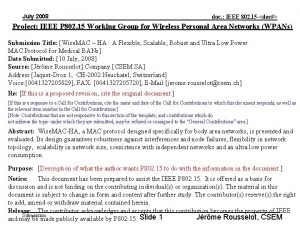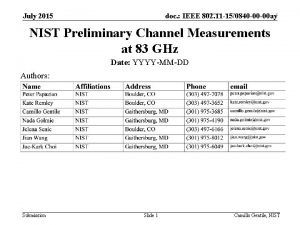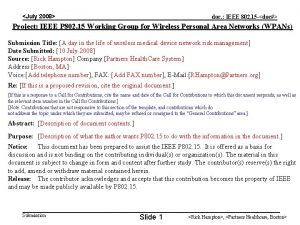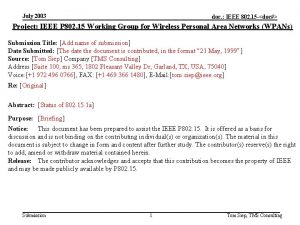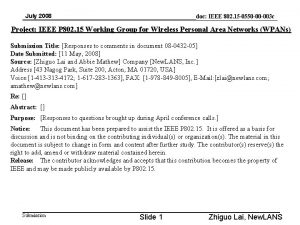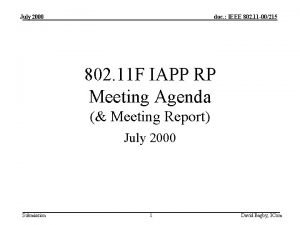July 2019 doc IEEE 802 11 191144 r















![July 2019 doc. : IEEE 802. 11 -19/1144 r 4 References [1] 802. 11 July 2019 doc. : IEEE 802. 11 -19/1144 r 4 References [1] 802. 11](https://slidetodoc.com/presentation_image_h2/da6fde3ade52e176d2fc950424d18a27/image-16.jpg)
- Slides: 16

July 2019 doc. : IEEE 802. 11 -19/1144 r 4 Channel Access for Multi-link Operation Date: 2019 -07 -15 Authors: Name Affiliation Address Phone Email Insun Jang insun. jang@lge. com Jinsoo Choi js. choi@lge. com Jeongki Kim LG Electronics Suhwook Kim 19, Yangjae-daero 11 gil, Seocho-gu, Seoul 137130, Korea jeongki. kim@lge. com suhwook. kim@lge. com Sungjin Park allean. park@lge. com Taewon Song taewon. song@lge. com Submission Slide 1 Insun Jang, LG Electronics

July 2019 doc. : IEEE 802. 11 -19/1144 r 4 Introduction • In the last meeting, Asynchronous (or independent) operation and Synchronous (or simultaneous) operation are addressed as modes of multi-link aggregation/operation [1]-[6] • In this contribution, we discuss the operation and channel access for those modes Submission Slide 2 Insun Jang, LG Electronics

July 2019 doc. : IEEE 802. 11 -19/1144 r 4 Modes of Multi-link Operation • Both of Asynchronous (Async. ) mode and Synchronous (Sync. ) mode are proper multi-link operations to increase the peak throughput by aggregating multi-links • Basically, we need to consider channel access for (re)transmission using multi-link operation Submission Slide 3 Insun Jang, LG Electronics

July 2019 doc. : IEEE 802. 11 -19/1144 r 4 Enabling Asynchronous Mode • In Async. mode, an 11 be STA (re)transmits and receives frames on each link independently – It means that simultaneous (independent) DL/UL over multi-link can happen • However, Async. mode can cause the interference by out-of-band (OOB) emission unless their channels are sufficiently away [6] – It mainly would occur between channels in a band (e. g. , 2 channels in 5 GHz) • Therefore, the Async. mode will require a method for reducing the interference such as large distance between channels Submission Slide 4 Insun Jang, LG Electronics

July 2019 doc. : IEEE 802. 11 -19/1144 r 4 Channel Access in Asynchronous Mode • For the Async. Mode (satisfying the requirements), each EDCA parameters set (e. g. , contention window (CW), AIFSN, etc. ) should be used on a primary channel of each link, independently Submission Slide 5 Insun Jang, LG Electronics

July 2019 doc. : IEEE 802. 11 -19/1144 r 4 Channel Access in Asynchronous Mode with Common TID • In Async. mode, a common TID over multi-link may be supported – It means traffic flows for a common TID can be transmitted on multi-link – Especially, support of a common TID over multi-link enables a retransmission on some other links on behalf of the link that an initial transmission is performed for the quick re-ordering • Independent EDCA on each link can support the transmission on multi-link with a common TID without any problems Submission Slide 6 Insun Jang, LG Electronics

July 2019 doc. : IEEE 802. 11 -19/1144 r 4 Enabling Synchronous Mode • Sync. mode is a proper alternative not to generate the interference between links – It means that simultaneous (independent) DL/UL Tx over multi-link is not supported, i. e. , DL only Tx or UL only Tx over multi-link is supported • Therefore, Sync. mode requires the synchronization of the timing of transmission – It can have a single primary channel or multiple primary channels over multi-link Submission Slide 7 Insun Jang, LG Electronics

July 2019 doc. : IEEE 802. 11 -19/1144 r 4 Channel Access in Synchronous Mode with Single Primary • Sync. mode with a single primary channel would use the original EDCA channel access over all of links to aggregate links as in the single-link • For more than 160 MHz, an additional rule might be needed (e. g. , Secondary 160) Submission Slide 8 Insun Jang, LG Electronics

July 2019 doc. : IEEE 802. 11 -19/1144 r 4 Channel Access in Synchronous Mode with Multiple Primary • Sync. mode with multiple primary channels would use the original EDCA channel access in each link • To facilitate aligning the timing of transmission over multi-link, it needs to design a proper channel access over multi-link – For example, if BC of a link becomes zero and the channel states of other links during a certain period are idle, frames can be transmitted by using the links • A certain period can be PIFS for the priority or AIFS for the fairness Submission Slide 9 Insun Jang, LG Electronics

July 2019 doc. : IEEE 802. 11 -19/1144 r 4 Discussion on Mode Operation • Operation mode (Async. or Sync. ) can be maintained without change, e. g. , – Sync. Mode only operate on several links due to interference – Async. Mode only operate on several links without interference • Operation mode may be changed, e. g. , Async. -> Sync. -> Async. • For some use cases such as applications requiring considerable amount of traffic in a short time Submission Slide 10 Insun Jang, LG Electronics

July 2019 doc. : IEEE 802. 11 -19/1144 r 4 Summary • We have discussed the operation and channel access in both of Asynchronous mode and Synchronous mode • Asynchronous mode can perform the independent EDCA channel access on each link even in case of a common TID • Synchronous mode with multiple primary needs to perform a proper channel access to facilitate multi-link aggregation while Synchronous mode with a single primary would perform the original channel access used in a single link Submission Slide 11 Insun Jang, LG Electronics

July 2019 doc. : IEEE 802. 11 -19/1144 r 4 Straw Poll 1 • Do you agree that the 802. 11 be amendment defines Asynchronous mode for multi-link operation? – Asynchronous mode means frames are transmitted independently over multiple links by STAs belonging to a multi-link capable device regardless of downlink or uplink – Note: Exact name of mode can be changed • Y/N/A: 42/12/43 Submission Slide 12 Insun Jang, LG Electronics

July 2019 doc. : IEEE 802. 11 -19/1144 r 4 Straw Poll 2 • Do you agree that the 802. 11 be amendment shall support Synchronous mode for multi-link operation? – Synchronous mode means only following transmissions are allowed • A PPDU is transmitted on one link by a STA belonging to a multi-link logical entity (MLLE) • N DL PPDUs are transmitted concurrently over N links by STAs belonging to a multi-link logical entity (MLLE) (N>=2) • M UL PPDUs are transmitted concurrently over M links by STAs belonging to a multi-link logical entity (MLLE) (M>=2) – Note: Exact name of mode can be changed Submission Slide 13 Insun Jang, LG Electronics

July 2019 doc. : IEEE 802. 11 -19/1144 r 4 Straw Poll 3 • Do you support that each link has a primary channel in Synchronous mode? Submission Slide 14 Insun Jang, LG Electronics

July 2019 doc. : IEEE 802. 11 -19/1144 r 4 Motion #1 • Move to add the followings to the 11 be SFD: – Define the following multi-link operation • Frames are transmitted independently over multiple links by STAs belonging to a multilink capable device regardless of downlink or uplink Submission Slide 15 Insun Jang, LG Electronics
![July 2019 doc IEEE 802 11 191144 r 4 References 1 802 11 July 2019 doc. : IEEE 802. 11 -19/1144 r 4 References [1] 802. 11](https://slidetodoc.com/presentation_image_h2/da6fde3ade52e176d2fc950424d18a27/image-16.jpg)
July 2019 doc. : IEEE 802. 11 -19/1144 r 4 References [1] 802. 11 -19/0731 r 0 EHT Multi-link Operation [2] 802. 11 -19/0766 r 1 Enhanced Multi-band/Multi-channel Operation [3] 802. 11 -19/0764 r 0 Multi-Link Aggregation: Gain Analysis [4] 802. 11 -19/0823 r 0 Multi-Link Aggregation [5] 802. 11 -19/0821 r 0 Multiple Band Operation Discussion [6] 802. 11 -18/1908 r 0 Overview of Full Duplex over Multi- Band (FDMB) for EHT Submission Slide 16 Insun Jang, LG Electronics
 Bridges from 802.x to 802.y
Bridges from 802.x to 802.y Bridges from 802.x to 802.y
Bridges from 802.x to 802.y Ieee 802 family
Ieee 802 family Ieee 802 3 compliance
Ieee 802 3 compliance Ieee802.22
Ieee802.22 Arquitetura ieee 802
Arquitetura ieee 802 Ieee 802 que es
Ieee 802 que es Ieee 802 standard
Ieee 802 standard Bluetooth ieee 802
Bluetooth ieee 802 802 ieee
802 ieee Ieee 802
Ieee 802 Program kerja tata usaha smk 2019 doc
Program kerja tata usaha smk 2019 doc Doc 4444 icao 2019
Doc 4444 icao 2019 July 14 1789
July 14 1789 June too soon july stand by
June too soon july stand by Sylvia plath poppies in july
Sylvia plath poppies in july Tender mean
Tender mean











